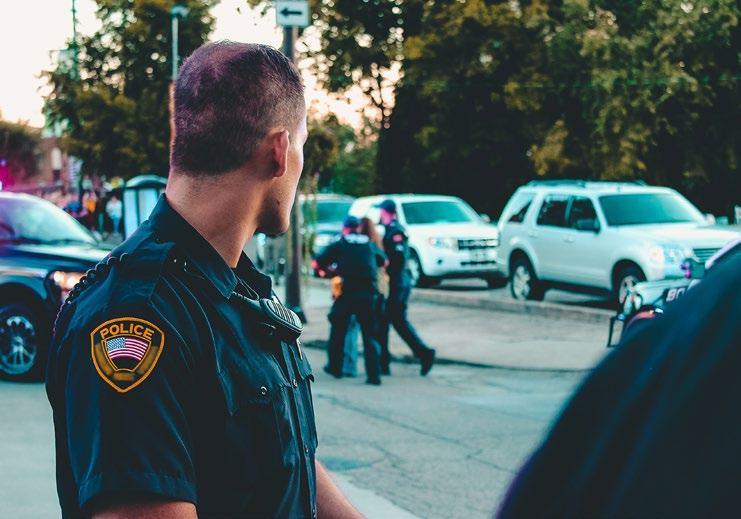
8 minute read
Exploring Criminal Justice Reforms, By Zach Friend, Supervisor, Second
By Zach Friend, Supervisor, Second District
Advertisement
The Criminal Justice Council of Santa Cruz County was created more than 30 years ago in an effort to provide increased coordination and cooperation between criminal justice partners — government, non-profit, educational and others — to reduce youth involvement in gangs.
The Criminal Justice Council, or CJC, focuses discussions on prevention and intervention as well as reentry programs — rather than simply a suppression model.
For example, a little over a year ago the CJC hosted a conference on the role of women and girls in gangs. The conference afforded criminal justice and community service providers and the community at-large an opportunity to hear from experts on the role of women and girls in gangs as well as a panel of young women with lived experience in gangs.
This is a rarely-discussed facet of gang involvement and one that the CJC felt was important to highlight in order to improve how communitybased outreach occurs to women/ girls in gangs. As a result of the conference, agencies began looking into outreach efforts to this population and ways they could improve reaching women and girls who are in, or may join, gangs.
Additionally, the CJC has worked with school districts, nonprofits and others on intervention and prevention programs to reduce youth involvement in gangs in general. From supporting educational efforts, nonprofit sporting leagues, conferences that provide viewpoints from those with lived experience and more. The CJC does these events with volunteers and small contributions from the member agencies.
Who Is On The CJC?
Awide variety of community public safety partners serve on the CJC.
Local police chiefs, the county sheriff, the chief probation officer, district attorney, leadership of two local nonprofits, two local judges, the public defender, the county superintendent of schools, the president of Cabrillo College, two county supervisors, elected representatives from the local cities and more participate.
It’s a diverse group that, having participation from local education and nonprofit social program providers, helps create discussions beyond just backend suppression activity toward front-end prevention opportunities.
Focus This Year
This year, the CJC decided to focus our efforts on law enforcement policies and procedures and working to standardize (where possible) some policies across the county.
Many local agencies have begun to implement reforms — including policies around warrants and community contact. But often these policies aren’t known and if they don’t exist there isn’t necessarily a standard in understanding where the gaps are or how current policies can be improved. With these diverse perspectives at the table this year, CJC is hoping to create a model for criminal justice efforts such as communicating existing policies and creating greater criminal justice reforms — including policy and procedure updates.
To Learn More
The CJC meets quarterly and these meetings are open to the public. Over the last year (and into the foreseeable future) these meetings have been virtual. The next meeting of the CJC is on May 13 at 3 p.m. As an all-volunteer organization we are still working on a website with more information on the CJC and future/upcoming meetings (the website is santacruzcjc.org) but you are always welcome to call my office and we can provide you with the link for attending.
For the last few years I’ve served as chair of the CJC and would be happy to provide additional information. n •••
If you have any questions about the CJC, or any other matters in our district, please don’t hesitate to call me at 454-2200. I’m maintaining regular updates on social media at www.facebook.com/supervisorfriend regarding COVID updates and other Countyrelated matters.




LocalLocal NewsNews ...... LocalLocal SportsSports ...... LocalLocal PoliticsPolitics ......

High Energy, Lotsa Love
Hiya, hiya, hiya!! I’m Flipper (A279631), but I call myself FLIPS! Why? Because watch this! *does jump-spin.* Cowabunga dude! Or, um, whatever the people here say. Give me a break, I’m from Modesto! Anyways…HIYA! I’m Flipper, aka FLIPS, and I’m buzzing with excitement for a new home! Shelter staff says I’m a 9 month old, 47lbs, Keeshond mix that is compact and full of energy! Sounds like what they meant to say is, “When you ADIPT the FLIP, it’s time to ZIP”…wait…I don’t know if that…
PLAYTIME! That’s what I’m about! Play by myself? I’m my favorite entertainment! Play with other dogs? It’s a tumblin’ fun time! Play with all the humans? Let there be toys! When it’s play time, it’s Flip time; and ain’t no Flip time like a quick zip Flip time! In other words, I’m looking for a fun, fun, fun new family that can keep up with me physically and mentally! Sure I’m young. I may pull a bit on leash, chase all the squirrels, and get super excited … but for the warmth of a new home I’m willing to learn! Just give me patience and love, and I’ll give you lots of fun!!
So come meet me for play time! You can email Jill at jillian.ganley@santacruzcounty.us to set up an appointment.
Adoptions are first come, first served! Please view available animals on our website and then visit the Shelter to turn in your application. All adoptions require proof of home ownership or landlord approval. Please have this information prepared. If an animal is in Foster Care, please bring in your adoption application and schedule an appointment to meet the animal. Call 831-454-7200 x0 during business hours or visit www.scanimalshelter.org for more information! n •••
Santa Cruz County Animal Shelter’s full-service, open-admission shelter:
Santa Cruz Location (Public Entrance): 1001 Rodriguez St., Santa Cruz, 95062
Hours: Daily 10 a.m. – 6 p.m.
Watsonville Location: CURRENTLY CLOSED 580 Airport Blvd, Watsonville, CA 95076
SCCAS Main line: 831-454-7200. Animal Control: 831-454-7227. After-Hours Emergency: 831-471-1182 • After Hours: jillian.ganley@santacruzcounty.us
In the Garden
© Statepoint Media

COMMUNITY NEWS CDC Changes School Desk Guidance
Science Says Three Feet Between Student Desks Plus Masks Provide Safety
Editor’s Note: On March 20, the California Department of Public Health updated its K-12 Schools Guidance allowing three feet instead of six feet between student desks in classrooms for in-person instruction with students wearing masks. This guidance at https://www. cdph.ca.gov/Programs/CID/DCDC/Pages/ COVID-19/COVID19-K12-Schools-InPersonInstruction.aspx aligns with the latest science reflected by the March 19 update from the federal Centers for Disease Control and Prevention. Here is the federal update. •••
On March 19, the federal Centers for Disease Control and Prevention updated K–12 school guidance to reflect the latest science on physical distance between students in classrooms. CDC now recommends that, with universal masking, students should maintain a distance of at least 3 feet in classroom settings.
CDC has updated its operational strategy to say: • In elementary schools, CDC recommends all students remain at least 3 feet apart in classrooms where mask use is universal — regardless of whether community transmission is low, moderate, substantial, or high. • In middle and high schools, CDC recommends students should be at least 3 feet apart in classrooms where mask use is universal and in communities where transmission is low, moderate, or substantial. • Middle school students and high school students should be at least 6 feet apart in communities where transmission is high, if cohorting is not possible.
Cohorting is when groups of students are kept together with the same peers and staff throughout the school day to reduce the risk for spread throughout the school. This recommendation is because
COVID-19 transmission dynamics are different in older students – that is, they are more likely to be exposed to
SARS-CoV-2 and spread it than younger children.
The updated Operational Strategy for K-12 Schools through Phased Prevention at https://www.cdc.gov/ coronavirus/2019-ncov/community/ schools-childcare/operation-strategy. html#anchor_1616080121423 is part of CDC’s existing resources for K–12 schools to open and remain open for inperson instruction during the COVID-19 pandemic. This update removed recommendations for physical barriers, clarified the role of community transmission in decision-making, clarified that ventilation is a component of strategies to clean and maintain healthy facilities, and added guidance on interventions when a cluster of three cases occur.
Since release of the Operational Strategy on Feb. 12, 2021, CDC has continually reviewed the evolving evidence on SARS-CoV-2 transmission in K–12 schools, as well as the latest science on the effectiveness of different prevention strategies within schools. The updated guidance complements CDC’s existing guidance, resources, and tools for K–12 schools.
Three studies, published in the March 19 Morbidity and Mortality Weekly Report, address spread of SARS-CoV-2 in schools. Taken together, these studies build on evidence that physical distancing of at least 3 feet between students can safely be adopted in classroom settings where mask use is universal and other prevention measures are taken.
“CDC is committed to leading with science and updating our guidance as new evidence emerges,” said CDC Director Rochelle Walensky. “Safe in-person instruction gives our kids access to critical social and mental health services that prepare them for the future, in addition to the education they need to succeed. These updated recommendations provide the evidence-based roadmap to help schools reopen safely, and remain open, for inperson instruction.” n





